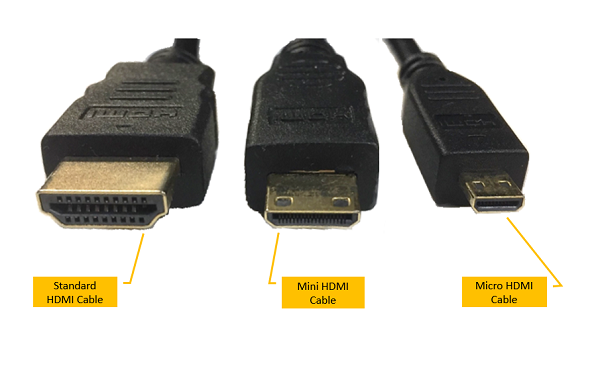HDMI Cable and Connector Types
Audio/video technology is continually advancing and the specifications for High-Definition Multimedia Interface (HDMI) equipment are occasionally adjusted and revised to guarantee capability and optimal performance. With the various HDMI cable types, it can be frustrating when determining which cable is best for certain displays. Below is a guide for the different HDMI cable and connector types that can assist in finding the correct cable for a variety of configurations.
HDMI Cable Types
Click or the topic for details:
Standard HDMI Cable
Standard HDMI Cables are designed for commonly used applications and are tested to transmit 720p up to 1080p, known as High Definition (HD) resolution. This cable does not transmit 4K (3840x2160 up to 4096x2160) resolution. Standard HDMI Cables are recommended for satellite television, screen projectors, DVD players, and other common displays.
Standard HDMI Cable with Ethernet
Standard HDMI Cables with Ethernet also offer the same capabilities and performance as Standard HDMI Cables, but additionally have a dedicated data channel, known as the HDMI Ethernet Channel. Both linked devices must have HDMI Ethernet Channel enabled for data transmission functionality. This cable does not transmit 4K resolution. There are very few products that support Ethernet over HDMI compatibility. For example, particular Blu-Ray Disc Players and Home Theater Systems support Ethernet streaming channels.
High Speed HDMI Cable
High Speed HDMI Cables handle resolutions of 1080p up to 4K at 60 Hz. This cable type also includes display technologies such as 3D and Deep Color. High Speed HDMI Cables are recommended in a configuration where a 1080p display is being connected to a 1080p source, such as a 4K capable video game console or a Blu-ray Disc Player.
High Speed HDMI Cable with Ethernet
High Speed HDMI Cables with Ethernet provide the same features as High Speed Cables such as resolutions of 1080p up to 4K. This cable type includes display technologies such as 3D and Deep Color. High Speed HDMI Cables with Ethernet have a dedicated data channel, known as the HDMI Ethernet Channel. Both linked devices must have the HDMI Ethernet Channel enabled for data transmission functionality. There are very few products that support Ethernet over HDMI compatibility. For example, particular Blu-Ray Disc Players and Home Theater Systems support Ethernet streaming channels.
Premium High Speed HDMI Cable and Premium High Speed HDMI Cable with Ethernet
Premium High Speed HDMI Cables and Premium High Speed HDMI Cables with Ethernet are certified for reliable performance when using 4K or Ultra HD (UHD) video. These cables include features such as resolution at 60 frames per second with High-Dynamic Range (HDR), expanded color spaces including BT:2020, and 4:4:4 chroma sampling.
Ultra High Speed HDMI Cable
Ultra High Speed HDMI Cables can deliver high-bandwidth features including 4K, 5K (5120 x 2880), 8K (1780x4320), and 10K (10328x7760) at 120 Hz. This cable supports 48 Gbps bandwidth and features low electro-magnetic interference (EMI) that reduces interferences with nearby wireless devices. Ultra High Speed HDMI Cables also include the HDMI Ethernet Channel.
| Note | Cable manufacturers have the option to exceed the minimum requirements for cables. Contact the manufacturer for details about their cables. |
Determining Which HDMI Cable Type You Have
To help clarify cable types, HDMI Licensing LLC. has required products to be labeled with Cable Name Logos. Packaging will also indicate the cable type.
| Note | The labeling standard was not required until 2010. Previously purchased cables may indicate the cable type on the connector head or the cable itself. |

Example of labeled HDMI cables.
HDMI Connector Types
Click or the topic for details:
Standard HDMI (HDMI Type A)
Standard HDMI Connector Types use a 19 pin configuration, carrying video and audio signals. This connector type is commonly used for a variety of at-home devices like TV's, computers, and video game consoles.
Extended Pin HDMI (HDMI Type B)
Extended Pin HDMI Connector Types use an extended 29 pin configuration, carrying video and audio signals. This design is less commonly used.
Mini HDMI (HDMI Type C)
Mini HDMI cables use a 19 pin configuration, carrying video and audio signals. This connector type is commonly used for recording devices, tablets, and other small devices.
Micro HDMI (HDMI Type D)
Micro HDMI cables provide the same features at the Mini HDMI but uses a smaller 19 pin configuration. This connector type is commonly used for cell phones, small cameras, and other portable devices.

Example of HDMI Connectors.
Video Cable Adapters
Video cable adapters allow for various configurations if you are missing a particular port on your display device. Some examples of display adapters include DisplayPort to HDMI, Mini DisplayPort to USB-C, HDMI to VGA, and more.
Using adapters may cause various issues such as poor picture quality, missing video or audio, screen flickering, and other various video/audio issues. In some configurations, certain capabilities may be lost. It is strongly recommended to use a different cable in replacement of a display adapter to avoid possible issues.
Troubleshooting and Additional Information
If you receiving an incorrect video/audio output on your display, please go through the guide on this web page to determine if you are using the correct cable. For more troubleshooting and additional information, please review the related topics below.